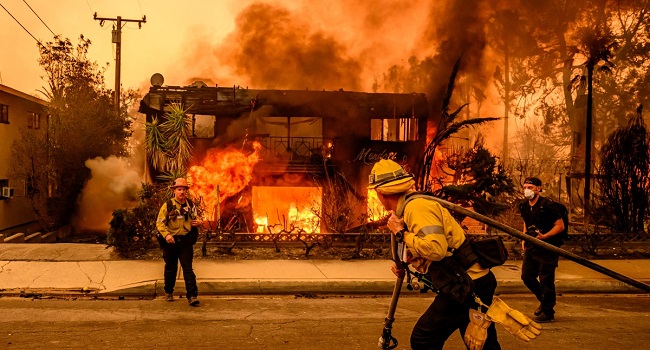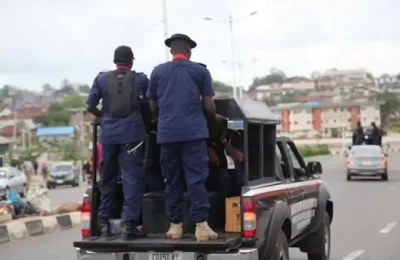Wildfires are raging in several areas of Los Angeles, with high winds and extremely dry conditions fuelling their progress across thousands of acres of land.
The most destructive wildfires in Los Angeles’s history have razed neighborhoods, forced desperate evacuations and threatened wealthy, iconic parts of the city and they appear far from being contained as firefighters strain against fierce winds and dry conditions.
Firefighters are so far unable to contain a number of them.
The largest blaze, in the Pacific Palisades area where many celebrities live, is the most destructive fire in the history of Los Angeles. More than 5,300 buildings have been destroyed.
Among the buildings already destroyed are many of the exclusive properties that line the Malibu waterfront.
Three fires have been contained.
Woodley fire: Small fire reported in local parkland. Burnt area: 30 acres.
Olivas fire: Small fire first reported in Ventura county about 50 miles (80km) east of Los Angeles. Burnt area: 11 acres.
Sunset fire: Reported in the historic Hollywood Hills area near many famous landmarks, including the Hollywood sign. Burnt area: 43 acres.
Five fires are still burning in the Los Angeles area.
Palisades fire: The largest active fire is burning between Santa Monica and Malibu. Burnt area: more than 20,000 acres. More than 5,300 structures destroyed. At least 30,000 people evacuated.
Eaton fire: Second largest fire burning north of Pasadena. Burnt area: at least 13,690 acres. Potentially more than 4,000 structures damaged or destroyed. Five deaths reported.
Hurst fire: To the north east of the city. Burnt area: 850 acres.
Lidia fire: Reported in the hills north of Los Angeles. Burnt area: 350 acres.
Kenneth fire: In the West Hills area, just north of the Palisades. Began on Thursday afternoon and has so far burned 960 acres.
How did the fire spread?
The Palisades fire spread, intensified in a matter of hours. At just after 14:00 on Tuesday it covered 772 acres and within four hours it had approximately tripled in size.
It now covers almost 20,000 acres and thousands of people have been forced to evacuate the area, as more than 1,400 firefighters try to tackle the blaze.
The Eaton fire has also grown rapidly from about 1,000 acres on Tuesday to more than 13,000 acres, forcing thousands more people to flee.
Largest fires have burnt thousands of buildings
As the maps below show, about 20,000 buildings may have been damaged or destroyed already in the two biggest fires – and many more could be at risk depending on how the fires spread.
Where are the fires burning?
Five fires are threatening Los Angeles area residents from the north, east and west.
The largest and most destructive, the Palisades fire along the Pacific Coast, had scorched more than 17,000 acres and was 0 percent contained as of Thursday afternoon, according to Cal Fire. The fire forced evacuations along the Pacific Coast Highway, including the Pacific Palisades, Malibu and Santa Monica.
The next largest fire lies to the east: the Eaton fire, raging north of the city of Pasadena in the San Gabriel Mountains. It has burned more than 10,000 acres, destroyed hundreds of homes and placed tens of thousands of people under evacuation orders. An official said on Thursday that the fire’s growth had been “significantly stopped,” though the fire was still 0 percent contained.
North of the Palisades fire and west of the Eaton fire, the Hurst fire in the San Fernando Valley has extended to more than 800 acres. And in the Angeles National Forest, a vast area spread across the San Gabriel Mountains and Sierra Pelona Mountains, firefighters managed to contain 40 percent of the Lidia fire, which has consumed more than 300 acres.
The Sunset fire, which ignited on Wednesday in the Hollywood Hills in Los Angeles and threatened landmarks like the Hollywood Bowl and the TCL Chinese Theater, was fully contained by Thursday, after consuming 43 acres.
How many homes have been destroyed?
Preliminary reports indicate that the Palisades fire has damaged or destroyed thousands of structures, officials said on Thursday.
If confirmed, the Palisades fire would rank among the five most destructive fires in California history. The residences in these areas include iconic mansions on bluffs that tower over the Pacific, as well as tract homes in beachside neighborhoods.
The Eaton fire has burned over 1,000 buildings, officials said. Flames had seriously damaged at least part of the Pasadena Jewish Temple and Center, which has been operating for more than a century.
The extent of the damage caused by the other fires remained unclear.
Have there been any fatalities?
Officials have confirmed that the Eaton fire killed at least five people. But the number of fatalities will likely be higher, according to Robert Luna, the Los Angeles County sheriff.
“Frankly, we don’t know yet,” he said of the death toll.
While there haven’t been any fatalities reported from the Palisades fire, some firefighters suffered injuries while battling the blaze.
And there have been a “high number of significant injuries” among people who didn’t evacuate their homes when they should have because of that fire, said Anthony C. Marrone, the fire chief for Los Angeles County.
ALSO READ:Los Angeles fires: Trump blames California gov, calls him ‘Gavin Newscum’
Why did these big fires break out at the same time?
Forecasters for days had warned of damaging wind gusts that would reach 50 to 80 m.p.h., and even above 100 m.p.h. in the mountains. The winds, combined with dry air, created a critical fire-weather event in Southern California. The hills are also covered in vegetation after two rainy winters that preceded this one.
Late fall and winter tend to spawn catastrophic fires in California. In periods without significant precipitation, as has been the case this winter, the vegetation becomes extremely parched. And cooler weather in California coincides with the Santa Ana winds, the strong and dry gusts that blow west from Nevada and Utah into Southern California — and are linked to the region’s most devastating fires.
The deadliest and most destructive fire in California’s history, which destroyed the Northern California town of Paradise, broke out in mid-November 2018.
Are the fires expected to keep growing?
The Santa Ana winds that fueled the fires’ rapid spread eased slightly on Thursday morning, allowing firefighters to continue air operations and make incremental progress against some of the blazes. New water supplies replenished fire hydrants that ran dry in some areas after excessive demand early in the battle against the fires.
The most destructive fires, however, remain out of control. City and county fire officials said their priority is saving lives and protecting property, rather than establishing containment lines.







